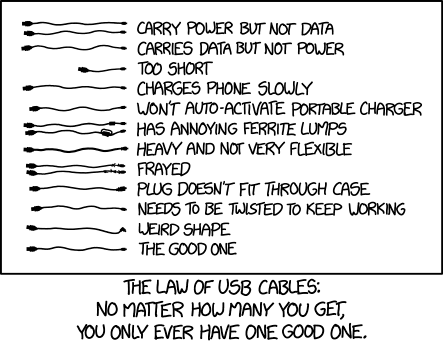 Last year, Google showed off WaveNet, a new way of generating speech that didn’t rely on a bulky library of word bits or cheap shortcuts that result in stilted speech. WaveNet used machine learning to build a voice sample by sample, and the results were, as I put it then, “eerily convincing.” Previously bound to the lab, the tech has now been deployed in the latest version… Read More
Last year, Google showed off WaveNet, a new way of generating speech that didn’t rely on a bulky library of word bits or cheap shortcuts that result in stilted speech. WaveNet used machine learning to build a voice sample by sample, and the results were, as I put it then, “eerily convincing.” Previously bound to the lab, the tech has now been deployed in the latest version… Read MoreJean-Philippe Encausse
Shared posts
Google’s WaveNet machine learning-based speech synthesis comes to Assistant
 Last year, Google showed off WaveNet, a new way of generating speech that didn’t rely on a bulky library of word bits or cheap shortcuts that result in stilted speech. WaveNet used machine learning to build a voice sample by sample, and the results were, as I put it then, “eerily convincing.” Previously bound to the lab, the tech has now been deployed in the latest version… Read More
Last year, Google showed off WaveNet, a new way of generating speech that didn’t rely on a bulky library of word bits or cheap shortcuts that result in stilted speech. WaveNet used machine learning to build a voice sample by sample, and the results were, as I put it then, “eerily convincing.” Previously bound to the lab, the tech has now been deployed in the latest version… Read MoreDo you smell that? Prolitec brings “ambient scenting” to the IoT market
Retailers and other commercial operations have long used ambient scenting to influence the customer experience, but global leader Prolitec is adding a new level of control by combining the smell technology with an IoT distribution and regulation system.
The post Do you smell that? Prolitec brings “ambient scenting” to the IoT market appeared first on Digital Trends.
Ce bijou connecté améliore votre voix pour vous aider à chanter juste
[Idée partenaire] OnTune est un objet connecté surprenant qui prend la forme d’un médaillon qui améliore votre voix pour vous aider à chanter juste.
Chanter faux n’est plus une fatalité. Si vous n’avez absolument aucun talent pour le chant, il existe désormais un accessoire révolutionnaire qui va vous aider à y remédier. Deux Français ont imaginé OnTune, un médaillon connecté qui améliore votre voix pour vous aider à chanter plus juste. Et aussi surprenant que cela puisse paraître, ce produit existe bel et bien.
OnTune a été créé en collaboration avec des professionnels de santé, principalement des ORL. Au niveau de l’apparence, le médaillon ressemble à un petit galet qui vient se positionner au niveau du larynx et des cordes vocales. Et c’est là toute la subtilité du produit : OnTune envoie des ondes aux muscles et nerfs de votre larynx pour moduler la hauteur de votre voix. C’est donc en jouant directement sur ces ondes au niveau de votre larynx que le médaillon va être capable de vous permettre de chanter juste.
OnTune possède une autonomie de 6 heures, et le médaillon fonctionne avec une application mobile qui vous permet d’ajuster divers paramètres. Elle vous permet également d’enregistrer, puis de partager vos vocalisations. En bref, OnTune est le produit parfait pour vous assister dans la pratique du chant. Si vous chantez extrêmement mal, OnTune ne fera sans aucun doute pas de miracle, mais le cas échant il vous aidera à chanter juste.
Commercialisé à partir de 129 euros, ce médaillon révolutionnaire devrait être disponible dès l’automne. Pour en savoir plus, rendez-vous sur le site officiel du constructeur ou sur sa page Facebook.
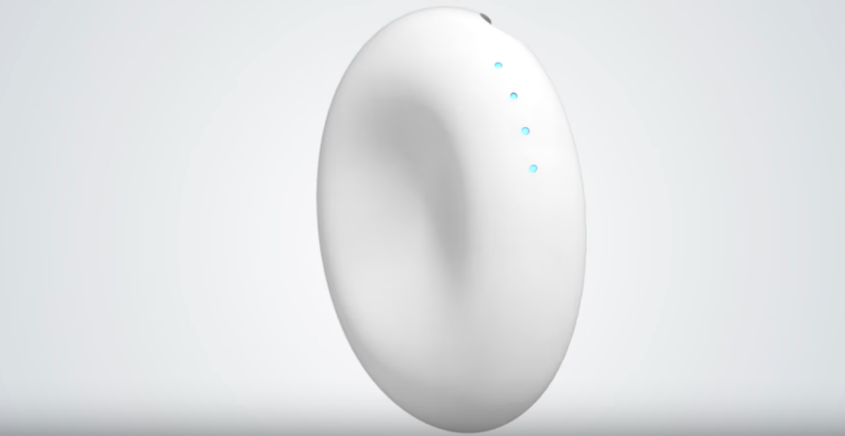
Crédits : OnTune

Crédits : OnTune
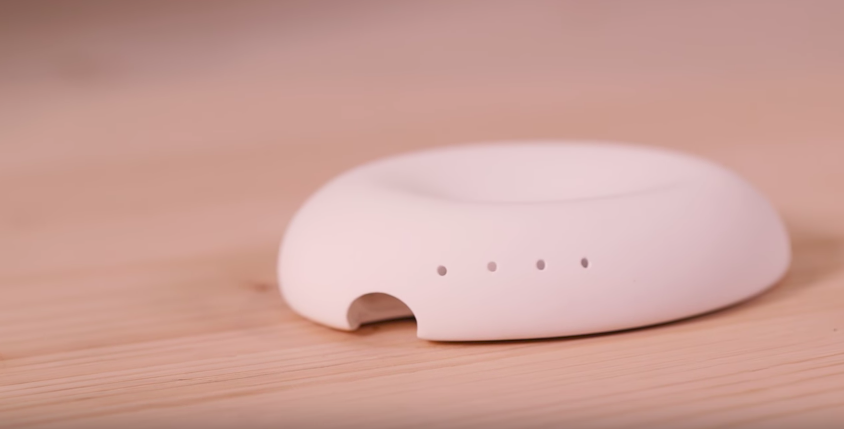
Crédits : OnTune
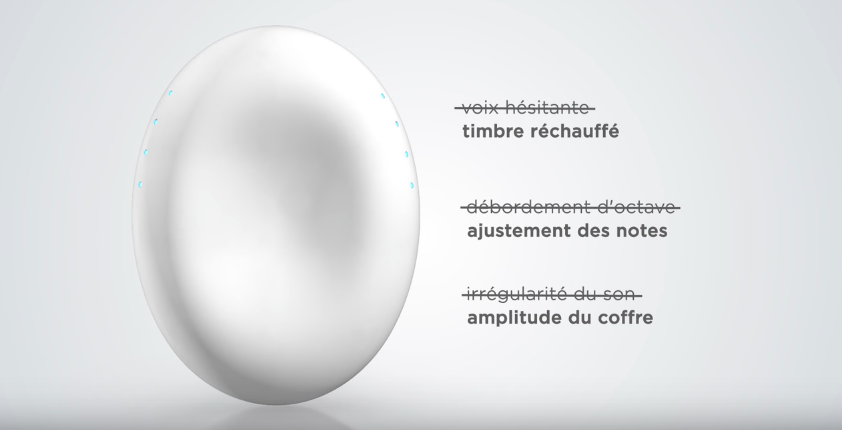
Crédits : OnTune

Crédits : OnTune

Crédits : OnTune
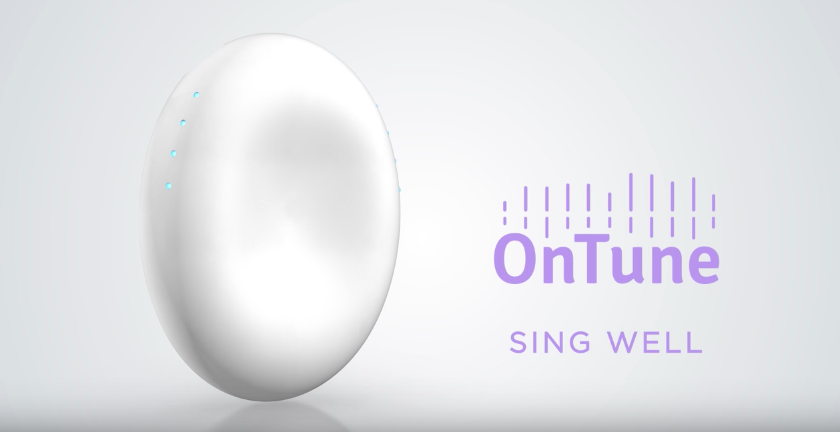
Crédits : OnTune
Source OnTune
Cet article Ce bijou connecté améliore votre voix pour vous aider à chanter juste provient du blog Creapills, le média référence des idées créatives et de l'innovation marketing.
Un câble à 160 Tbit/s de 6 600 km de long traverse l'Atlantique

This veteran gamer created his own high-tech D&D custom table
Dungeons & Dragons is growing in popularity in the digital age, and this veteran gamer created his own custom table with a 4K display and touchscreen capability.
The post This veteran gamer created his own high-tech D&D custom table appeared first on Digital Trends.
Meet the Man Creating Freakily, Disturbingly Realistic Masks
What does it take to make a face? Try $4,500. At Landon Meierâs studio, you can try on a new face for a day. Meier specializes in creating hyper-realistic (and hyper-expensive) masks that could easily pass for the real thing. Take a test run at being Walter White, or try on Mike Tyson for sizeâMeierâs surreal and nightmarish creations cover a whole range of celebrities and politicians, including the ever-popular viral sensation âCrying Baby.â Making these masks is no easy taskâeach one could take up to a year to complete. But for Meier, watching the astonished reactions to his craft makes it all worth it...(Read...)
Dropbox Launches DBX Platform and New APIs
Dropbox has announced the launch of the DBX Platform, a suite of APIs and developer tools for building new capabilities on top of Dropbox. The company also announced the release of two new APIs; Metadata API and File Requests API. These new APIs are built on Dropbox API V2, the revamped API released in 2015 that replaces Dropbox API V1. Version 1 of the Dropbox API will be shut down on September 28, 2017.
What Google doesn’t want you to know: Voice search is taking over display search, while Assistant…
What Google doesn’t want you to know: Voice search is taking over display search, while Assistant and chatbots are emerging
The greatest jump in the history of search is happening under our eyes and Google is keeping pretty quiet about it.
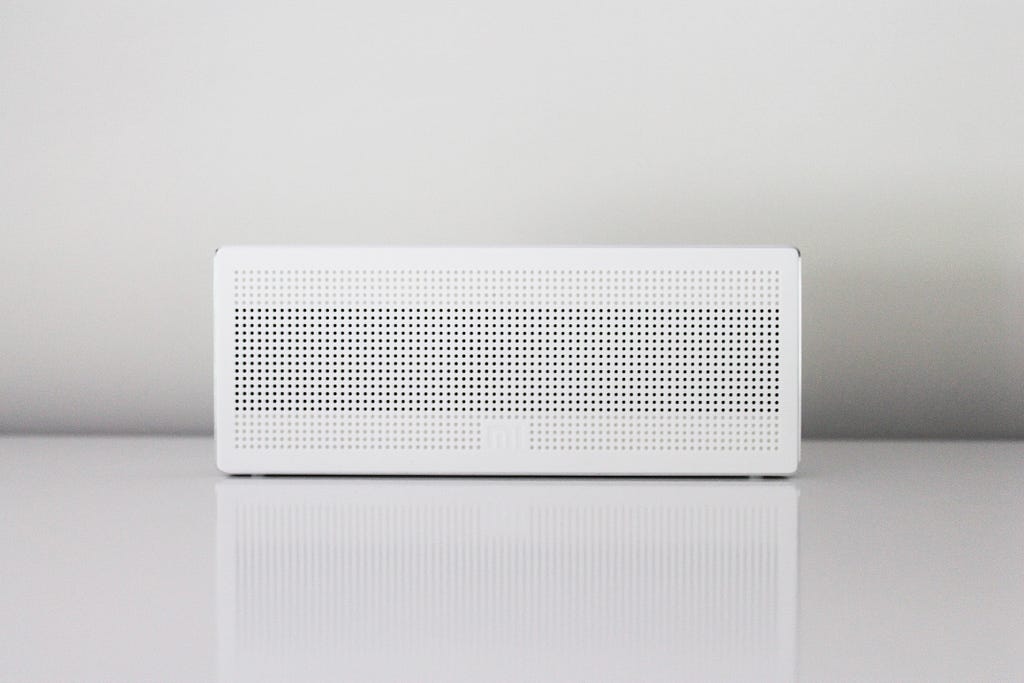
Last year, Google announced and Hitwise estimated that around 58% of all Google searches were mobile, and more than 20% of mobile searches were via voice. Sources inside Google have hinted that voice search is approaching 25% of mobile now and some expect it to go above 50% in the next 3 to 5 years. For example, voice search was cited as the fastest growing type of search, according to the keynote speech given by Behshad Behzadi, Principal Engineer at Google Zurich, at SMX West in March 2017. Why is this happening?
2017 is the year of voice — starting at 8mm, ending with 950mm voice devices
We started 2017 with an estimated 8mm voice devices, mostly Amazon Echos with some Google Homes. An industry report from VoiceLabs estimates a total voice-first device footprint of 33 million devices in circulation by the end of 2017.
However, VoiceLabs missed something big. In May 2017, Google announced that its Actions on Google platform was activated for all Android devices natively, meaning that voice search via Google Assistant and Action was fully enabled. Why is this important? Because Google Assistant and Actions are what power Google Home — it basically makes any Android phone the equivalent of a Google Home (and any iPhone that has the Google Assistant app downloaded on it). Assistant the the smart helper behind voice search, and Actions allows any developer to build on top of Assistant and have their action, skill, or app featured on Google.
So in May 2017, Google had ~100mm Android devices with Google Assistant and Actions a button away. Since Android cycles through new users every quarter, all 2bn monthly active users of Android globally will eventually come onto the Assistant and Actions platform as they upgrade, with ~350mm new activations each quarter. Using this data you can infer:
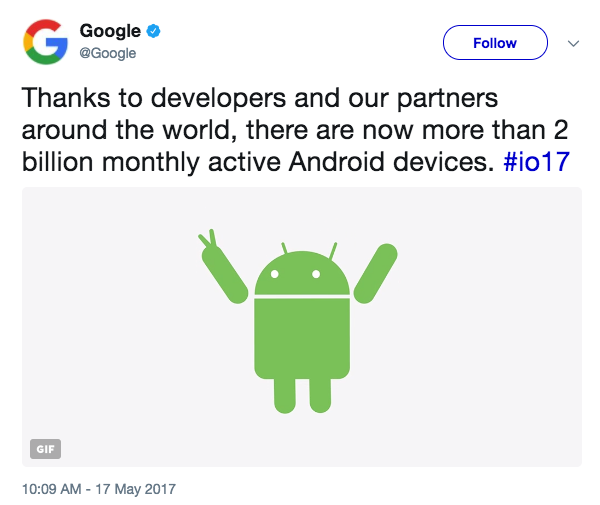
Google will end 2017 with between 850–950mm users that have voice search and a fully voice-first device in their pocket and home.
This is a big deal because the quality of the voice-first devices depends on how good the intent matching is, which depends on the total number of users. It’s the economics of big data — the quality of the service depends on the size of the chat data set. So as customers gravitate to the better devices, Google will continue to outpace Amazon Alexa. Most serious tests so far have shown that Google Assistant (available on Home, all Android devices, and iOS) is far superior to Alexa at answering questions and figuring out what users want. See this test with 54 questions and this study with thousands of questions, where they found that Google Assistant is 6 times more likely to answer your question than Amazon Alexa. Finally Google and Higher Visibility have reported that most people use voice search to call people, ask for directions, play songs, and search for information.
Why is Google quiet about voice search if it’s winning?
Because they’re still figuring out how to build their ad business model around voice. Google reported that mobile searches are less profitable with less revenue per click, and the company is still really early in figuring out how to do voice search ads. Google’s CEO Sundar Pichai has also been quiet when Wall Street analysts ask him how they will monetize voice search. Google just doesn’t know — they are running all sorts of internal experiments right now on voice ads. Their engineers are quiet because they have to figure out how to disrupt their own cash cow business of desktop and mobile search.
What does the rise of voice search mean?
Speech will take over typing and texting because it is 3x as fast with 20% fewer errors
Researchers at the Stanford Human Computer Interaction Lab found that with speech recognition, the English input rate was 3.0x faster, and the Mandarin Chinese input rate 2.8x faster, than a state-of-the-art miniature smartphone keyboard. Further, with speech, the English error rate was 20.4% lower, and Mandarin error rate 63.4% lower, than the keyboard.
Websites on the open web are over — no one spends time in browsers
Content creators will have to partner with Google Assistant and Actions, as the new platform, or other interactive platforms like Amazon Alexa, Facebook Messenger, or Snapchat. Websites are losing out as US users spend more time using apps than watching TV, and roughly 33% of time is spent on Facebook / Snapchat / and text messaging versus 8% of time in browsers. It’s also likely that the app world is over, as a majority of US smartphone owners download zero apps per month and spend most of their time on a few app platforms like Facebook, Messenger, Snapchat, and so on.
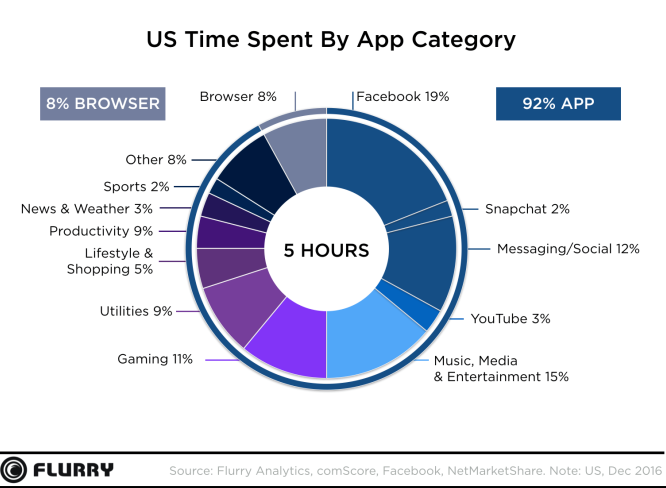
Chatbots are the new delivery form that will win with voice search
Voice search is about interactivity: questions, answers, guided flows, and conversations. Websites are mostly static, like brochures from the print days. If you look closely at the Google Actions and API.AI platforms, they are essentially chatbot platforms. Facebook Messenger is a massive chatbot platform, as are Kik and Telegram. Still not convinced? Read what the chatbot entrepreneur of Octane AI, Matt Schlict writes: “How Bots Will Completely Kill Websites and Mobile Apps.”
Adtech is going through a big disruption: SEO and SEM business models are getting blown apart
If you thought the move from desktop first to mobile first was a big deal, get ready for the move from mobile websites to “ambient voice-first”, where your phone and other talking devices surround users and are ready to serve them. A static website isn’t enough — you need an interactive AI agent to really engage with users. Here is a list of reasons why voice search will totally change SEO.
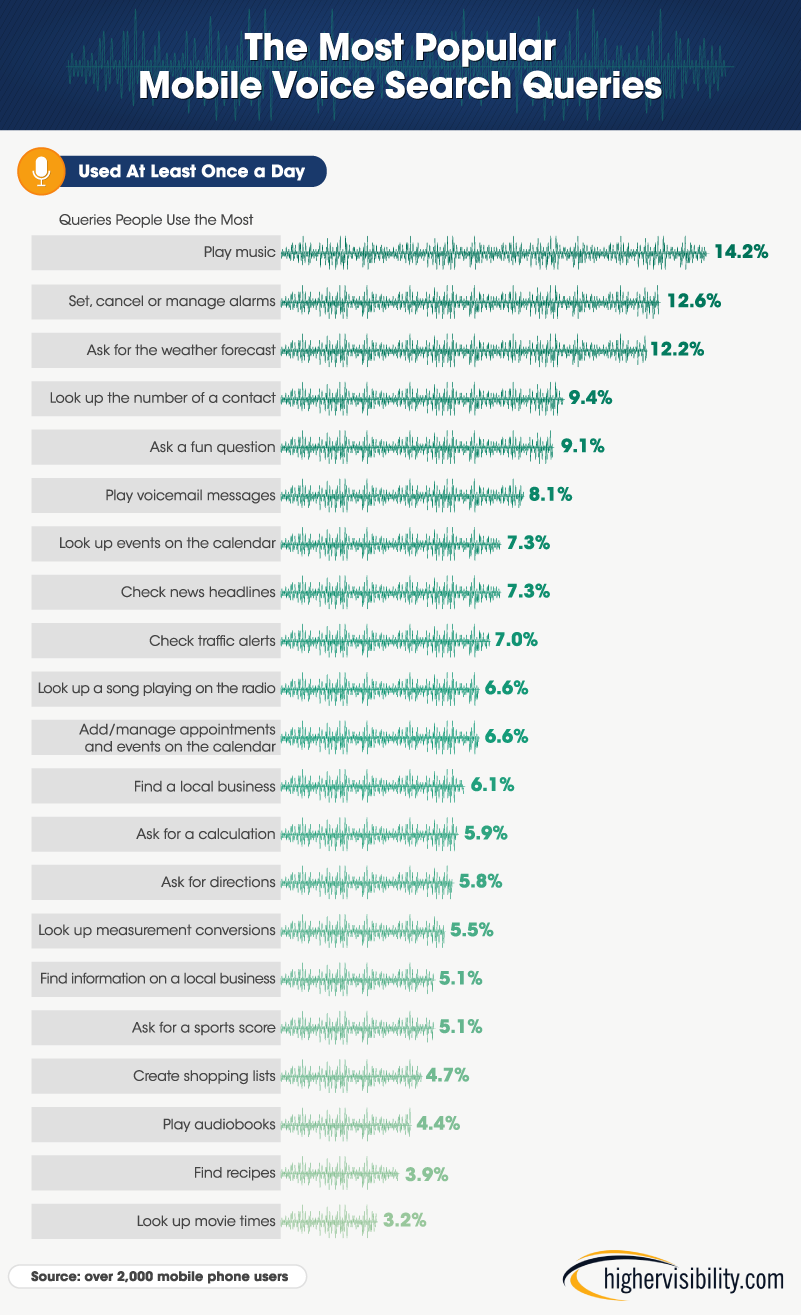
What Google doesn’t want you to know: Voice search is taking over display search, while Assistant… was originally published in Chatbots Magazine on Medium, where people are continuing the conversation by highlighting and responding to this story.
Viseo développe un chatbot pour Direct Energie
Google Cloud’s Natural Language API gets content classification and more granular sentiment analysis
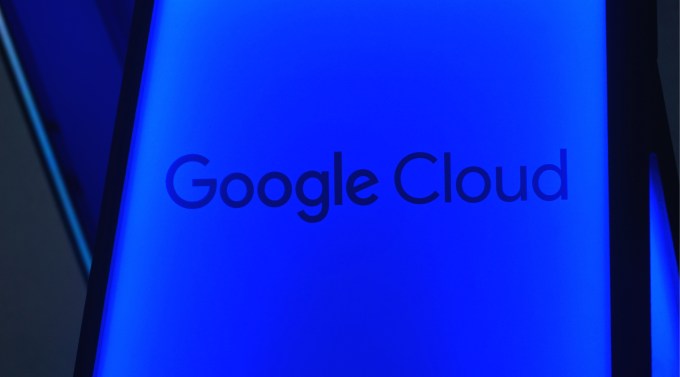 Google Cloud announced two updates this morning to its Natural Language API. Specifically users will now have access to content classification and entity sentiment analysis. These features are particularly valuable for brands and media companies For starters, GCP users will now be able to tag content as corresponding with common topics like health, entertainment and law (cc: Henry).… Read More
Google Cloud announced two updates this morning to its Natural Language API. Specifically users will now have access to content classification and entity sentiment analysis. These features are particularly valuable for brands and media companies For starters, GCP users will now be able to tag content as corresponding with common topics like health, entertainment and law (cc: Henry).… Read MoreRemarkable E-ink Writing Slate Reviews – Great Tablet, But Not Ready for Prime Time
If that early buzz for the $600 Remarkable tablet had you wishing that you had gotten in on the early pre-orders, I have good news for you:
It's not ready yet.
A handful of reviews were posted on Friday, and they show reveal that the Remarkable still has a way to go in the software department (this could explain why it missed the official mid-August shipdate).
This writing slate measures 10.1" by 6.9" by 0.36" thin, and according to official specs it weighs about 12 ounces. runs a proprietary Linux OS on a 1GHz CPU with 512MB RAM and 8GB of internal storage (there is no card slot).
It has a 10.3" Carta E-ink display (1872 x 1404 resolution - 226 PPI). The Remarkable doesn't have a frontlight, but it does have a capacitive touchscreen and a Wacom stylus that supports 2,048 levels of pressure sensitivity and 512 degrees of tilt detection.
Aside from the screen and the stylus, those specs sound like what you can find on a $100 to $200 ereader, and you can also find cheaper ereaders that are almost s good as the Remarkable (like the Onyx Boox M96, which costs $430, runs Android with a 9,7" E-ink screen, and has both dual-touchscreens).
Is the remarkable worth the extra $170 for an ereader cum writing slate?
Based on the following reviews, I would say yes - once the software is done.
Stuff.co.nz
At £529 just for the tablet, with the pen sold separately, this is a seriously expensive device. It’s fantastic at what it does, and the crowdfunding campaign that got it off the ground has been a resounding success, but prioritising the writing experience above all else has forced some compromises.
With no backlight or frontlight, a Kindle is still probably your best bet if you're mainly after an eBook reader. Digital artists that aren’t interested in working purely in greyscale will be better served by an iPad Pro or Microsoft Surface, even if their respective styli can’t match ReMarkable for convincing feel.
Business Insider
I was excited about the potential of the reMarkable tablet, but unfortunately, it didn't quite meet my expectations.
That said, I still think it's an incredible product. The instantaneous nature of the ink is truly impressive, and every person I showed it to was blown away. The prospect of being able to take handwritten notes but save them digitally — not to mention sync them to your computer — is thrilling for those who prefer notepads over notepad apps.
But in making the quickest writing and drawing experience it could, I felt like reMarkable sacrified quickness on the other end. The device's tendency to burn-in was a real problem, as was the slowness to turn the page or navigate back to the home screen. The tablet's user interface still needs work to make it more intuitive, and the overall design could look slightly more modern. In its current form, paying $600 for an E Ink tablet like this in 2017 still seems too steep to me.
Wired
Even the best paper notebook needs a good pen—or in this case, a good stylus, to be worth using. The reMarkable comes with a Wacom stylus that works impressively well on the e-ink display, with hardly any latency. It’s tilt and pressure sensitive for better accuracy, but the results can be shaky, so don’t count on it replacing your sketchbook just yet. Those kinks aside, palm rejection works great, and the stylus doesn’t have a battery, so no need to awkwardly plug it into the bottom of your tablet.
When you’re done jotting down ideas for your screenplay or doodling away, you can bounce over to your eBooks tab and dive into The Jungle or Crash Override. Unfortunately, you won’t get as good a reading experience as you’d find on a Kindle due to a few shortcomings.
I found that text doesn’t look as crisp (limited font options don’t help things, either) and then there’s no bookstore so getting your digital library onto the reMarkable is a hassle. If those issues don’t bother you, there are some nice perks like a larger screen and the ability to write notes into a book’s margins, which you can’t do with a Kindle.
Laptop Magazine
The reMarkable's amazing writing experience is a one-of-a-kind feature that when combined with its cloud-sync capabilities and Photoshop-esque editing, makes it a great tool for note takers and artists alike. Writing on the slate is one of the most realistic, comfortable experiences I've had on a tablet, rivaled only by using an actual pen and paper.
Of course, $599 may be a tough price to swallow for some, especially when the device is made just for writing, drawing and reading. For a more feature-rich tablet, consider the $649 10.5-inch iPad Pro, which supports Apple's $99 Pencil stylus. It's $149 more expensive, though, and writing on its glass doesn't feel as natural. However, the iPad has Apple's huge library of apps and games, while reMarkable has a much more limited offering. Still, the reMarkable has to be used to be truly believed, as writers and artists looking for the best marriage of digital and analogue won't find a better option.
Popular Mechanics
The drawing is great, but navigating the tablet's interface is less so. You'll basically have to memorize the meanings of it icon-labeled on-screen buttons. I still routinely do things like delete an entire page of notes when I meant to select the eraser (undo to the rescue), or create a new page when I mean to navigate to anther digital notebook. I also found myself wanting to touch the on-screen buttons with my finger, as not to move the stylus away from what I was writing, and, frustratingly, this does work but only about 50 percent of the time.
The eBook Reader
In terms of ereading features, the reMarkable is very basic. It supports PDF and DRM-free ePub files, but the software is still a work-in-progress so that makes it hard to review at this point. They plan on adding more features over time; I’ll update this review to reflect any changes as they get added.
At present there’s no table of contents, no dictionary, no bookmarks, no search, no active hyperlinks, no back button, no annotations list, no pinch-zooming, no finger-swipe page turning.
What it does offer is a jump to page option and you can view a list of thumbnails to move around parts of a book.
There are a couple of different ways to zoom in. It has a cropping option that works quite well, and there’s a zoom dial to zoom in and out in increments. Zooming resets with each page turn but cropping remains.
You can add notes and highlights with the stylus, of course, but there is no list to view them or way to add bookmarks so it makes it kind of a hassle to find them unless you remember the page number they were on or manually scan through thumbnail view.
Digital Trends
The pen’s stellar performance stands in contrast to the rest of the experience, unfortunately.
The ReMarkable tablet suffers from the telltale limitations of E Ink technology: Tapping on a menu key or scroll wheel basically guarantees a delay and screen flashes while the tablet refreshes. It doesn’t come close to the responsiveness of the stylus, and it’s incredibly frustrating.
The ReMarkable tablet’s battery life is a little better than its performance, but it didn’t last as long as I’d like. After a typical 9-to-5 day of jotting down reminders, organizing my to-do list, and absent-mindedly doodling, I could count on the 3,000mAh battery dipping well below 40 percent by midweek.
ReMarkable’s engineers say they’re targeting two weeks of standby time, which seems a little optimistic. But we’ll have to take their word for it.
You just finished reading Remarkable E-ink Writing Slate Reviews – Great Tablet, But Not Ready for Prime Time which was published on The Digital Reader.
Google’s new payment app for India uses sound to transfer money

Google has introduced a new payment app in India called Tez (the Hindi word for “fast”). Tez features a technology called audio QR that allows users to transfer money using sounds to pair two devices. Called the “cash mode option,” phones negotiate a connection using audio to identify the payer and payee. (The sounds should be inaudible to human ears though because they’re sent using ultrasonic frequencies, according to the Financial Times.) The feature is therefore similar to cash transactions which don’t require the exchange of personal details like bank accounts and phone numbers. Cash Mode works with any phone with a mic and speaker and Tez app installed, and doesn’t require an NFC chip. Google’s Audio QR technology is similar to...
Microsoft’s AI camera app Pix is now a business productivity tool
 Microsoft Pix, the iOS camera app that leverages A.I. to help you take better photos, is venturing beyond being a tool for consumers with an update that now sees it able to assist with photos of business documents, whiteboards, post-it notes, and business cards. According to Microsoft, the additional support focused on office productivity made sense because people were already doing a lot… Read More
Microsoft Pix, the iOS camera app that leverages A.I. to help you take better photos, is venturing beyond being a tool for consumers with an update that now sees it able to assist with photos of business documents, whiteboards, post-it notes, and business cards. According to Microsoft, the additional support focused on office productivity made sense because people were already doing a lot… Read MoreInside Zero Latency’s Las Vegas VR Arena At The MGM Grand
Melbourne, Australia-based VR company Zero Latency has partnered with the MGM Grand Hotel & Casino to launch its latest eight-player virtual reality gaming location in the U.S.
The 2,000-square-foot arena, which opened last week, is the latest video game attraction for MGM’s Level Up gaming lounge. And it’s one of 20 Zero Latency arenas in operation around the globe, including locations in Orlando, Boston, Philadelphia, Wisconsin and the Poconos.
Zero Latency co-founders Tim Ruse (CEO) and Scott Vandonkelaar (CTO) told UploadVR that the plan is to add another 30 to 40 arenas by the end of next year with the goal of hitting 100 arenas by the end of 2019.
Zero Latency is building its brand in the location-based VR arcade business through this new partnership with the established MGM brand. Ruse said MGM is putting its full marketing muscle behind this new “Virtual Reality Powered by Zero Latency” arena.
“It’s great to add an arena to another tier one U.S. market, and to partner with a global household name like MGM,” Ruse explained. “Outside of the MGM brand boost and marketing platform, the global destination of Vegas allows us to market Zero Latency to tourists who can play and then pass the word to their friends when they return home.”
In other words, Zero Latency is betting that what happens in VR in Vegas doesn’t stay in Vegas. This arena is the first for the company near the West Coast of the U.S., where rivals like IMAX VR and The Void have opened up location-based arenas in New York and Utah with a Disneyland location featuring The Void’s Star Wars: Secrets of the Empire opening this fall.
Featuring an open space with no obstacles, the arena enables teams to freely explore the virtual environment together. The games have been designed to give the illusion of exploring huge spaceships or alien worlds, while players are steered through the same arena in different ways. While battling through a growing library of games (with three titles available and a fourth launching this month), teammates will see each other as full-motion avatars and stay in constant communication, allowing them to call for backup or ultimately compete for the highest score. There’s also a Zero Latency employee inside the arena with players to set them up for combat and oversee the game.
Players stay in contact with each other through Razer headphones and are outfitted with Razer OSVR HDK2 virtual reality headsets while wearing a military-grade backpack containing a high-performance Alienware laptop computer. There’s also a custom-made, two-handed rifle that offers multiple firing options in-game.
The MGM arena charges $60 per person for a 30-minute gameplay experience. And the VR arena is accessible to younger players through a side entrance that circumvents the casino floor.
All Zero Latency locations currently offer three different multiplayer games, including the tower defense shooter Zombie Survival, the zero gravity shooter Singularity and the puzzle adventure Engineerium. Each game lasts for 30 minutes and allows up to eight players to team up and play together. Vandonkelaar said a new zombie game will launch this fall, which combines elements from the first three games for a more in-depth 30-minute experience.
“Over 100,000 players have gone through our system now, and we’re applying lessons learned from those players and their experiences in our first three games,” Vandonkelaar explained.
“The new zombie game has been designed from the ground up to be an eight-player and we’re adding more intensity and more exploration to this game than our first zombie game has.”
Vandonkelaar said all of these initial games have been created using Unity, but the company is currently working on Unreal Engine 4 games. And this fall they’ll release an API and developer kit for third-party companies to create new games for this platform of VR arenas. Some of these games will enter private trials this fall with 2018 launches planned.
Internally, Vandonkelaar said development is under way for a competitive multiplayer game specifically designed for esports.
“We’re working on new content to allow our players to compete,” Vandonkelaar said. “There are a lot of challenges to make a compelling experience, and we’re limited by the amount of space we have to have in these arenas. But we’re making sure the competition is as fun as possible and is skill-based, so that it has everything else esports needs. We’re coming to the point as we have more sites where teams of people can compete against people who aren’t at the same location.”
“There’s an incredible opportunity for VR esports in our arenas,” Ruse said. “It’s not just about a team’s knowledge of gameplay and skills, but you have to move around the arena and work together to best the opposing team. We see VR esports as part of our near future. We’ve been investigating and working on it and we’re keen to get into that business.”
Zero Latency is also fine-tuning a spectating system for its arenas. This will allow players to stream their play sessions across existing platforms like Twitch and Facebook Live to share with friends. But it will also set up a spectating mode for esports competition.
“Players will be able to stream their VR gameplay to the world quite soon,” Vandonkelaar said. “Everyone will get the chance to see the streams, and players can watch them back afterwards.”
Ruse added that in testing, there’s a real connection that develops through watching players compete in VR because you can hear them communicate and see them move within the game worlds.
“It feels like you’re connecting with an actual person,” Ruse said. “Friends can watch friends play and see and compare high individual and team scores, which should help drive the engagement of people going in to play and stir up the competitive nature of gaming.”
As Zero Latency builds out its esports strategy, Ruse said the company has been talking to brands interested in VR esports.
“There are a lot of companies interested in esports,” Ruse said. “It’s something we can have sorted for next year.”
The esports audience could introduce brand new consumers to the Zero Latency brand. Ruse said the company’s core demographic is comprised of males 25 to 40 years of age globally. And 30% of Zero Latency customers are female.
“The majority of people up to 45 years old are gamers to various degrees,” Ruse said. “Because people are more receptive to playing games, they’re more comfortable with our VR tech and we’re seeing a broader range of people coming through. We’re also seeing a lot of people who are VR curious and want to experience it first-hand.”
MGM is betting big on gaming, adding this Zero Latency VR arcade experience to a growing assortment of skill-based games designed to lure younger crowds. Now visitors to the Las Vegas Strip will be able to escape the real world, and any gambling losses, by entering these VR worlds.
Tagged with: Zero Latency
Dodles brings your doodles to life
 I’ve always wanted to create my own animations. One idea is simple. My characters would be born, live, fall in love, and die in real time in a 80 year long masterpiece of constant animation. It would be a commentary on the death of the soul and the deep longing of men and women to be truly understood. My more complex idea would involve a princess who has to fight a dragon. With Dodles… Read More
I’ve always wanted to create my own animations. One idea is simple. My characters would be born, live, fall in love, and die in real time in a 80 year long masterpiece of constant animation. It would be a commentary on the death of the soul and the deep longing of men and women to be truly understood. My more complex idea would involve a princess who has to fight a dragon. With Dodles… Read MoreQuand tu es météorologue pendant un ouragan
Magnet Implants, Your Cyborg Primer
What would you do to gain a sixth sense? Some of us would submit to a minor surgical procedure where a magnet is implanted under the skin. While this isn’t the first time magnet implants have been mentioned here on Hackaday, [The Thought Emporium] did a phenomenal job of gathering the scattered data from blogs, forum posts, and personal experimentation into a short video which can be seen after the break.
As [The Thought Emporium] explains in more eloquent detail, a magnet under the skin allows the implantee to gain a permanent sense of strong magnetic fields. Implantation in a fingertip is most common because nerve density is high and probing is possible. Ear implants are the next most useful because oscillating magnetic fields can be translated to sound.
For some, this is merely a parlor trick. Lifting paper clips and messing with a compass are great fun. Can magnet implants be more than whimsical baubles?
I would like to tell about my magnet which has been implanted for three years. As an automation engineer, I am tasked with trouble-shooting electrical panels. This is often a laborious task which involves probing with a multi-meter and staring back-and-forth at schematics.
When asked to diagnose a troublesome panel for a band-saw by some coworkers, I decided to use my magnet as a diagnostic tool first since it was a five minute walk to my meter. Lo and behold, after a wave of my hand, I noticed that the transformer wasn’t emitting a large field, like I would expect. I traced that back to a tripped circuit breaker, which three other engineers had missed, and flipped it. The machine restarted normal operation after thirty seconds instead of thirty minutes.
My magnet is literally part of me and a valuable tool of my trade.
[The Thought Emporium] has been mentioned here for their guide to making graphene. You can find more biohacking at Cyberpunk Yourself or see a wildly different application of body-mounted magnets.
Filed under: Medical hacks
This Discord bot turns Pokémon into a text-based adventure

If you’re looking to sneak in a little Pokémon time without busting out a handheld device or phone, there’s a Discord bot for that. PokéWorld offers a stripped-down version of the classic catch ‘em all RPG, a text-only version that can be enjoyed at your own leisure.
To play, Discord users can either log onto the main PokéWorld server, or invite the bot onto a server of their own. It plays like a simplified, word-based version of the games. Users input text commands, which the bot dutifully communicates often, to explore the game’s world, battle, and of course capture pokémon.
A California-based programmer who goes by “Bioblaze Payne” created the bot; they started the project in late July and had a prototype completed...
KFC in China tests letting people pay by smiling

Alipay has launched a new way to pay for your KFC in China — by smiling. So far, the facial payment system is only available at a single KFC in Hangzhou, China. The company behind the technology, Ant Financial, an Alibaba subsidiary, says its Smile to Pay technology needs about one to two seconds of facial scanning with a 3D camera and a “live-ness detection algorithm” to check the identity of the person paying, who must also enter their mobile phone number to help guard against fraud. A beta version of Smile to Pay was introduced in 2015 by Jack Ma the founder of Alibaba.
“Taking the facial-recognition payment technology offline was no easy task,” said Jidong Chen, head of biometric identification technology at Ant Financial. “On how we...
Bread Bag Alignment Chart

I am either lawful neutral or chaotic neutral. I’ve also been known to be neutral evil on occasion.
[Source: Aurelian Rabbit on Twitter | Via Neatorama]
The post Bread Bag Alignment Chart appeared first on Geeks are Sexy Technology News.
Settlers of Catan is coming to virtual reality this year

Iconic board game Settlers of Catan is coming to virtual reality. A new version is being developed by game studio Experiment7 — which previously created a pair of VR takes on chess — with feedback from the original minds behind Catan. The VR game, which is coming to both Oculus Rift and Gear VR and called simply Catan VR, is described as “true to the classic, but optimized for virtual reality” with “a fresh, fully-immersive format.” Unfortunately, right now the creators aren’t showing off what the new VR title looks like, though it appears that it will feature both a single-player and online multiplayer component.
Catan was first released as a physical board game back in 1995, and slowly built up a huge following as people became drawn...
Amazon Alexa is coming to the Bragi Dash

The Bragi Dash wireless earbuds are getting a new feature later this year: the ability to talk to Amazon’s voice assistant, Alexa. The headphone maker announced at the IFA trade show today that a software update coming in October will allow access to Alexa, and will be available in English (US and UK) and German.
It’s not the first pair of headphones to receive Alexa support, but this is definitely the first pair of truly wireless earbuds to offer access to the digital assistant. Alexa won’t be triggered by a wake word, though — users will have to either tap or use the Dash’s “4D menu,” in which the earbud uses motion sensing to allow users to turn their head left or right and select from a virtual menu.
Dash (and Dash Pro) users can...
XYZ Printing Unveils Inkjet-Based Filament Printer
XYZ Printing, makers of the popular da Vinci line of 3D printers, have just released one of the holy grails of desktop 3D printing. The da Vinci Color is a full-color, filament based printer. How does this work? A special filament (Color PLA, although this filament is white in color) is extruded through a nozzle like any other 3D printer. Color is then added layer by layer by a system of inkjets in the head of the printer. Yes, it’s a full-color 3D printer, and yes, people have been suggesting this type of setup for years. This is the first time it’s been made real.
The specs for this printer are about what you would expect from any other filament-based printer in 2017. The build volume is 200 x 200 x 150mmm, the print bed has auto-leveling (although strangely doesn’t have a heated bed), and the user interface is a 5-inch color LCD. The da Vinci Color is available for preorder right now for $2,999.
You can check out a few pics of samples printed on the da Vinci Color below:
In terms of brand recognition and XYZ Printing, their DaVinci is a somewhat surprising footnote in the history of desktop 3D printing. XYZ Printing’s da Vinci was one of the first cheap 3D printers with closed firmware, chipped filament, and a slightly terrible user interface. Nevertheless, the da Vinci was cheap and it could be hacked, turning it into a somewhat respectable printer.
As with any advancement in the state of desktop 3D printing, it must be mentioned that this is not. Color printing has been done before by members of the Open Source community. The exact same thing was done years ago with Sharpies, and I know RichRap experimented with markers and dye earlier than this, but I can’t find a reference. Full-color inkjets have been used in the past to create 3D prints, although these are powder-based printers, not filament printers. That doesn’t mean color printers can’t use filament; [Prusa]’s multicolor extruder is shipping soon, the Mosaic Palette splices filament to create multicolor prints (another RichRap invention circa 2011), and [Daren Schwenke]’s Arcus 3D has a mixing hot end that can create any color from CMYKW filament. There are many other solutions to full-color 3D printing that have been invented over the years, let us know your favorites in the comments below.
Filed under: 3d Printer hacks, news
Samsung is already releasing a smaller Frame TV

Samsung announced its design-oriented Frame TV less than a year ago, and already, the company is releasing a new, smaller model. A 43-inch version will join the 55-inch and 65-inch models that are already on sale. Samsung made the announcement at the IFA tech conference in Berlin this week, but didn't specify a timeline or pricing.
Existing models of the 4K HDR TV come with four HDMI ports, three USB ports, and supports all of the standard Samsung smart TV features. But what makes the Frame TV unique is the idea that it doubles as an art display. When it's not playing actual TV content, it cycles through photos and paintings, which come from partnerships with LUMAS, Saatchi Art, Sedition, and the Prado. Users can purchase additional...
LEGO Releases $800 7,541-Piece Millennium Falcon Set

That’s right, geeks, a Lego model of the Millennium Falcon that costs $800. Truly a thing of beauty. The set (Ultimate Collector Series #75192) will be available for purchase on 10/1/17 and will probably sell like hotcakes, even though you might need to remortgage your home to purchase it. Behold:







The post LEGO Releases $800 7,541-Piece Millennium Falcon Set appeared first on Geeks are Sexy Technology News.
Star Wars: Jedi Challenges AR Platform Launching This Holiday For $199
At the D23 Expo in Anaheim, CA earlier this year Lenovo and Disney revealed a partnership, with Lucasfilm, to work on a Star Wars-themed AR experience platform. Titled Star Wars: Jedi Challenges, users would don a specially created Lenovo headset, hold a replica lightsaber handle, and embark on a series of adventures and challenges to become one with The Force.
Today, Lenovo is announcing that the entire platform (Lenovo Mirage headset, lightsaber handle, tracking beacon, and AR apps) will launch this holiday season in November, 2017 for $199.99 and will feature “hours of gameplay.” You can pre-order it now at Best Buy and Lenovo.
The Jedi Challenges platform will feature three core experiences: lightsaber battles, strategic combat, and holochess. You’ll be able to fight in a lightsaber duel against the likes of Kylo Ren and even Darth Vader whereas the “strategic combat” is reportedly like a mini-RTS shrunk down onto the floor.
By looking down with the headset on you’ll see rebel and empire forces duking it out as you take control and command the armies. Finally, there’s holochess, because of course there is. In the videos above and below you can get a first-look at what there is on display from a video featuring the Carlin Brothers.
Once the headset is released all you need to do is download the Jedi Challenges app and slide the phone into Lenovo Mirage headset. You place the tracking beacon (shown below a couple of paragraphs) on the floor so it can see the lightsaber controller, and then you’re good to go. The headset looks like it works very similarly to the Mira Prism AR headset with the visor display.
There are two sensors on the front of the headset to provide inside-out positional tracking so you can easily move around the environment. Since the visor just rests in front of your eyes you can also easily see through the images and still get a feel for your physical surroundings, which is how it creates the illusion of augmented reality in a 3D space.
Once you pair the lightsaber you’ll use it for everything from fighting off Sith lords to selecting options in the menu. Lenovo describes it as a “collectible quality” replica Skywalker lightsaber handle.
“Through visible light-tracking technology, the headset’s sensors work together to lock onto the position of the Lightsaber controller, allowing players to see a beam form above the “hilt”, which they can use to block and interact with the universe in-game,” Lenovo states in its press release. “Haptic feedback is activated as players strike or block their opponents, while an inertial measurement unit sends rotational information from the controller to the smartphone to assist the beam in remaining stable mid-swing.
How all of this adds up to “hours of gameplay” remains to be seen, but it’s certainly an exciting thing to think about unwrapping beneath a Christmas tree this holiday season.
What do you think of the Star Wars: Jedi Challenges AR platform? Let us know down in the comments below!
Tagged with: Star Wars
How to Fit an Entire Outfit Into a Single Pair of Socks
How to Fit a Full Outfit Into Your Socks..(Read...)
Google’s ARCore Gets Unity And Unreal Support
World-building engines Unreal and Unity are both on board with support of Google’s new ARCore augmented reality toolkit.
For those unfamiliar, ARCore is the evolution of Google’s Tango platform that runs first on Google Pixel and Samsung Galaxy S8 with Android 7.0 or better running on it. It’s an answer to Apple’s ARKit, but available on fewer phones initially. We’ve had months of interesting projects rolling out on the Internet showing the capabilities of ARKit, but with Unity and Unreal support now in place for Google’s ARCore we’re likely to start seeing an increase in cool Android-based AR examples.
If you want to get started with Unity you need Unity version 2017.2 beta 9 or later and Android API SDK v.24 or later. Then download and import the ARCore SDK for Unity. the configure Unity “following the steps in the Unity Forum.”
If you want to get started with Unreal, check out the ARCore developer preview and the early access version available on GitHub. The software is planned for a larger roll-out with version 4.18 of the engine arriving in mid-October.
Tagged with: ARCore


